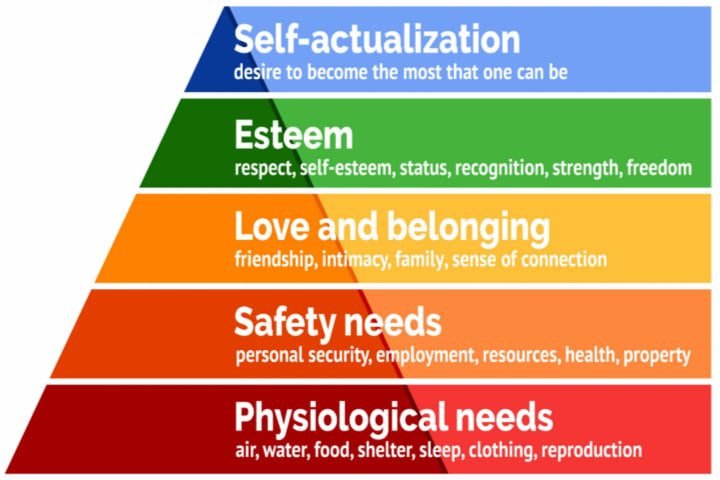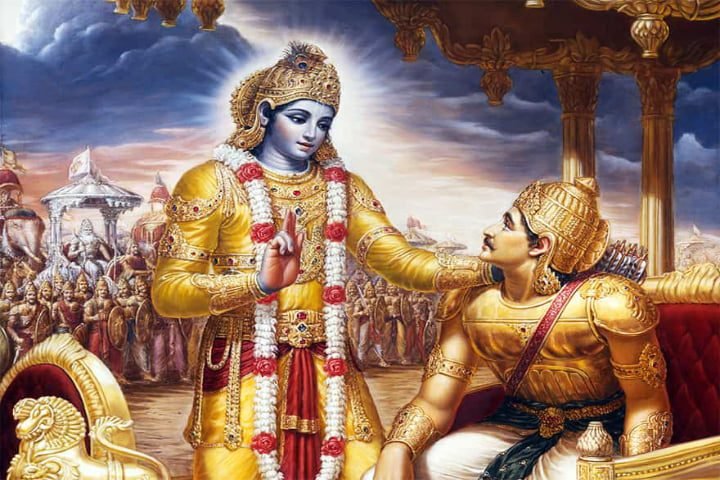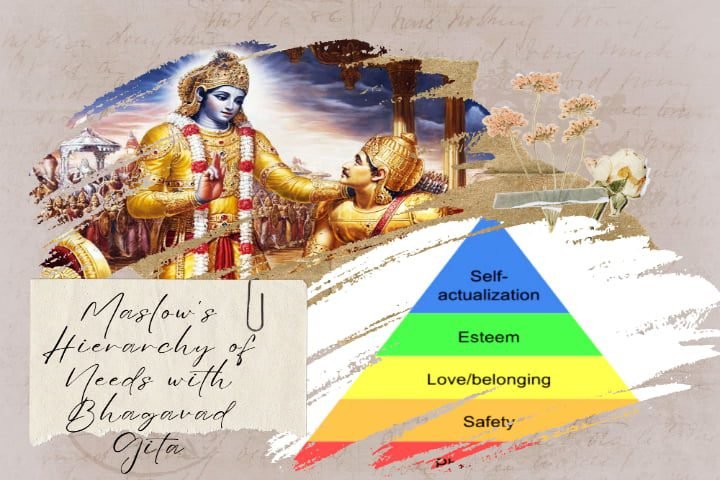5 Levels of Maslow’s Hierarchy of Needs
Maslow’s theory is based on the notion that a pyramid-like set of needs motivates humans. Each level represents a different aspect of our lives, and as we ascend this pyramid, we inch closer to self-actualization. At the ultimate level, we become the best version of ourselves.

Physiological needs
The foundation of Maslow’s pyramid is composed of physiological needs—the most fundamental requirements for human survival. These include air, food, water, shelter, and sleep.
Without satisfying these basic requirements, pursuing higher-level needs becomes nearly impossible. These needs are the most important to human bodies, and once they are satisfied, we can start looking higher up the pyramid.
Safety needs
Once our physiological needs are satisfied, we move up the pyramid to the second level, which is all about safety and security. This includes the need for physical safety and for our lives to be stable and predictable.
It’s the feeling of being safe from harm, knowing that our health and well-being are taken care of, and having some power over our lives. Being safe and sound gives us peace of mind and allows us to focus on other aspects of our lives.
Social needs

We move on to the third level, love and connection, once our physical needs are met and we feel safe. Humans are naturally social, and we want to connect with other people.
This order level shows the need for friendship, love, and belonging. It’s about making connections that matter, whether they’re with family, friends, or a romantic partner.
Meeting this need gives us a sense of community and emotional support, which is very important for our well-being.
Esteem needs
In the next stage, humans desire acceptance, respect, and a sense of self-worth. There are two types of esteem needs: the need for self-esteem, which includes having faith in yourself and a sense of accomplishment, and the need for the esteem of others, which means getting respect and recognition from people around you.
Achieving these needs is essential for maintaining a healthy sense of self-worth and a positive image of oneself.
Self-actualization needs

The idea of self-actualization, which means reaching one’s maximum potential, is at the very top of Maslow’s pyramid. Being the best version of yourself, living in line with your values, and fulfilling your unique talents and potential is what it means.
People who have reached self-actualization are known for being creative, good at problem-solving, and having a strong sense of purpose. Even though not everyone gets to this level, it’s still a great goal because it’s the highest level of human motivation and personal development.
The steps in the triangle show the processes that individuals or cultures go through as they mature. It is important to note that the 5 levels of Maslow’s Hierarchy of Needs do not indicate the duration an individual spends on each step.
The Interconnected Nature of the Levels
What makes Maslow’s theory so deep is how these five levels are linked to each other. The pyramid shows that we need to meet our basic needs first, and then we can move on to our more important ones. This concept highlights the importance of building a strong foundation for our personal development.
Understanding Maslow’s Hierarchy of Needs isn’t just about intellectual curiosity; it’s about personal transformation and growth. Recognizing where we are on the pyramid can help us set clear goals and priorities for our lives.
By identifying unmet needs, we can take concrete steps to address them, ultimately unlocking our full potential and living a more fulfilling life.
Comparing Maslow’s Hierarchy of Needs with Bhagavad Gita

The pursuit of self-actualization and understanding our deepest needs is a journey as old as humanity itself.
While the 5 Levels of Maslow’s Hierarchy of Needs provide a structured framework to analyze human motivations, the ancient wisdom of the Bhagavad Gita offers a unique perspective on self-realization.
Many people think of the Bhagavad Gita as being nothing more than a holy text that discusses renunciation and god. But true followers of this book believe it is more than just a book; they see it as the universe itself, filled with all the wisdom essential to realizing the maximum potential of individual and entire humanity.
Lord Krishna talks to Arjuna, his best friend, and teaches him about the philosophy of life. He talks about yoga, consciousness, the material modes of life, karma yoga, and finally, bhakti yoga.
The sole purpose of this book is to raise human awareness so that one can detach from materialistic greediness and take shelter in the supreme personality of the Godhead.
Awakening of Consciousness

Consciousness can be defined as the capacity to recognize and process information about the world around us and within ourselves.
In the Bhagavad Gita, Thamas Guna is characterized by a lack of organization and the presence of negative traits such as negativity, inactivity, ignorance, and hostility.
Those who possess Thamas Guna care about meeting their most fundamental needs, like water, food, and shelter, and are not inclined towards real knowledge. This aligns with what Maslow has described as a fundamental physiological need for all humans.
The Bhagavad Gita next describes the state of Rajas Guna, wherein one saves money and ensures his own safety. Lord Krishna added that a person in this guna has high standards for his actions and, as a result, develops his intellect.
A person at this point keeps working for improvement and is never satisfied with his current level of success. However, he never realizes that nothing is permanent. At this point, his standing in society will also be important to him.
Another major factor not mentioned in the hierarchy of needs is the social contribution of a person towards society. The Bhagavad Gita states that a man in Rajas Guna is also an active contributor to his society and environment.
Self-actualization in Maslow’s Hierarchy of Needs
An explanation of self-actualization can be found at Maslow’s Hierarchy of Needs peak. This is the top of the needs for a person to realize their ultimate goal. Maslow proposed several defining personality qualities that people tend to exhibit.
However, Maslow never concentrated on the social contribution to society; instead, he concentrated primarily on individual achievements, goals, and unleashing potential, thus making this theory self-centric.
When the human characteristics put forth in Maslow’s hierarchy are compared to the wisdom of the Bhagavad Gita, it suggests that Maslow’s Hierarchy of Needs lacks in communicating the essential wisdom to attain the ultimate human consciousness and thus achieving one’s maximum potential.
Stithprajnya Purusha in Bhagavad Gita
In the Bhagavad Gita, Lord Krishna explains the characteristics of “Stithprajnya Prusha” as a person who has distanced himself from the objects of pleasure and enjoyment, but the taste for such things remains inside one’s self. But even this taste decreases as his submission to the ultimate consciousness increases.
This corresponds to Maslow’s description of the peak moments that lead to an individual’s sense of self-actualization. Maslow, in his landmark work “Toward a Psychology of Being“, describes a group of people he calls “Peakers and Unpeakers,” whose experiences and traits are very similar to those of the Stithprajnya Purusha.
According to the Bhagavad Gita, Stithprajnya Purusha has the right to perform their prescribed duties but is never entitled to the fruits of their actions. They just do the karma and never expect results.
For such persons, humility, nonviolence, tolerance, simplicity, approaching a bona fide spiritual master, cleanliness, steadiness, and self-control are natural traits. For them, praises and insults are the same; they are silent and always content with anything.
A man who has learned the ultimate truth of knowledge sees everything around him as equal. Whether living or non-living, he sees “Paramathma” inside everything, which is also present inside him. He sees no differences whatsoever.
The 5 Levels of Maslow’s Hierarchy of Needs never go beyond talking about improving oneself and focusing solely on that goal. The Bhagavad Gita talks about self-transcendence, where one experiences beyond what is typically associated with being human.
An individual who has attained transcendence not only fully realizes his potential (Maslow’s “self-actualized” person) but also compassionately aids those around him in doing the same.
Analyses like these will help bridge the gap between Western thought and Indian literature at a time when a growing number of individuals are shifting toward more fulfilling ways of living, especially in the post-COVID-19 scenario in a changing world.
Also, in the world of marketing and communication, understanding human motivation is the key to creating successful campaigns. The 5 levels of Maslow’s Hierarchy of Needs offer invaluable insights for marketers looking to connect with their audience on a deeper level.
With this information in hand, one can better direct their marketing efforts and develop content that will genuinely connect with their target audience.




